Nursing Case Study: Acute Life-Threatening Condition & Interventions
VerifiedAdded on 2023/06/11
|8
|1286
|198
Case Study
AI Summary
This case study delves into the pathogenesis and pathophysiology of an acute life-threatening condition presented by a patient, focusing on congestive cardiac failure and fluid volume overload. It highlights the importance of nursing interventions, particularly encouraging rest, to alleviate clinical features and improve patient outcomes. The study also discusses the mechanisms of action, administration, and nursing considerations for medications like Furosemide and Glyceryl trinitrate, emphasizing the need for continuous clinical observations to monitor kidney function, fluid intake, urine output, and therapeutic responses. Desklib provides a platform for students to access this case study along with numerous other solved assignments and resources.
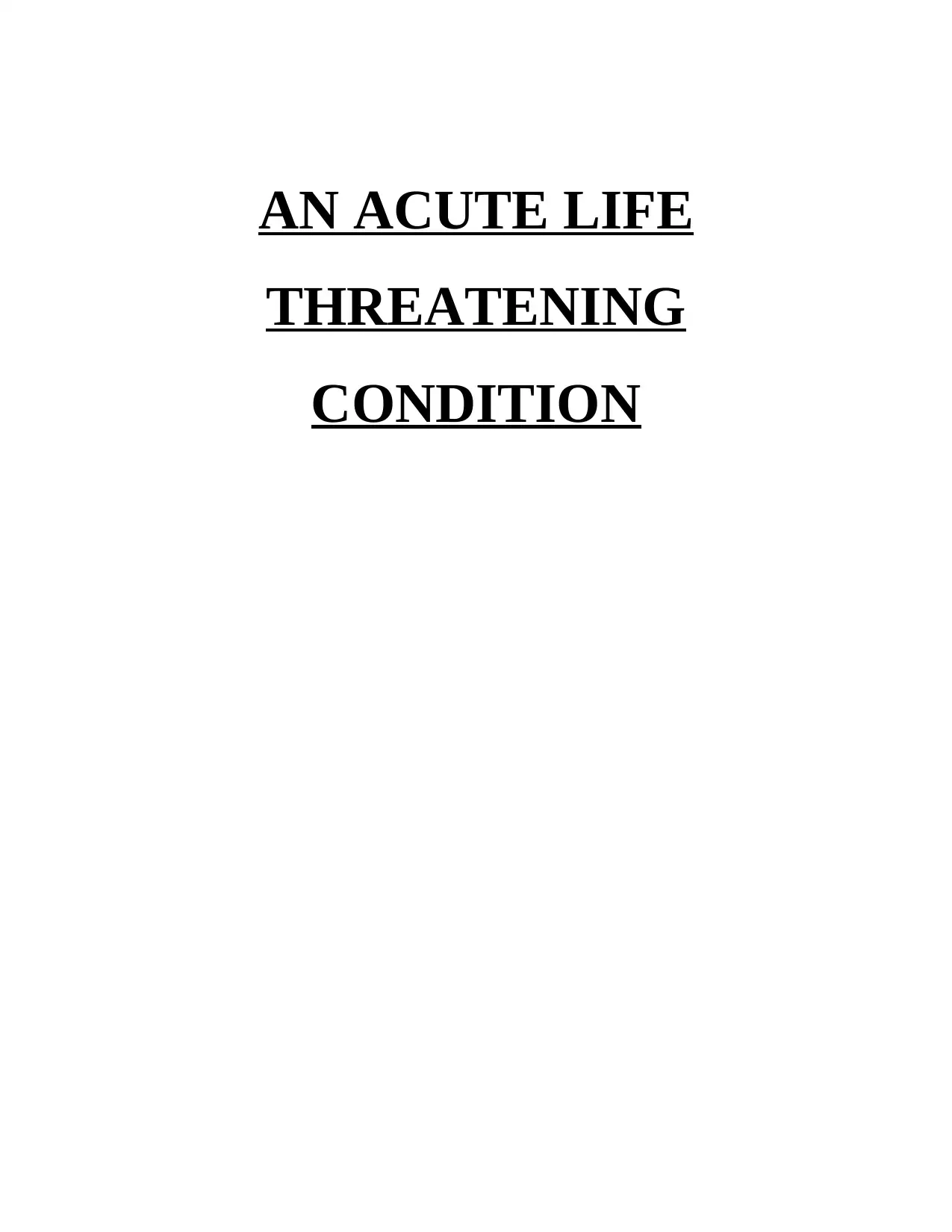
AN ACUTE LIFE
THREATENING
CONDITION
THREATENING
CONDITION
Paraphrase This Document
Need a fresh take? Get an instant paraphrase of this document with our AI Paraphraser
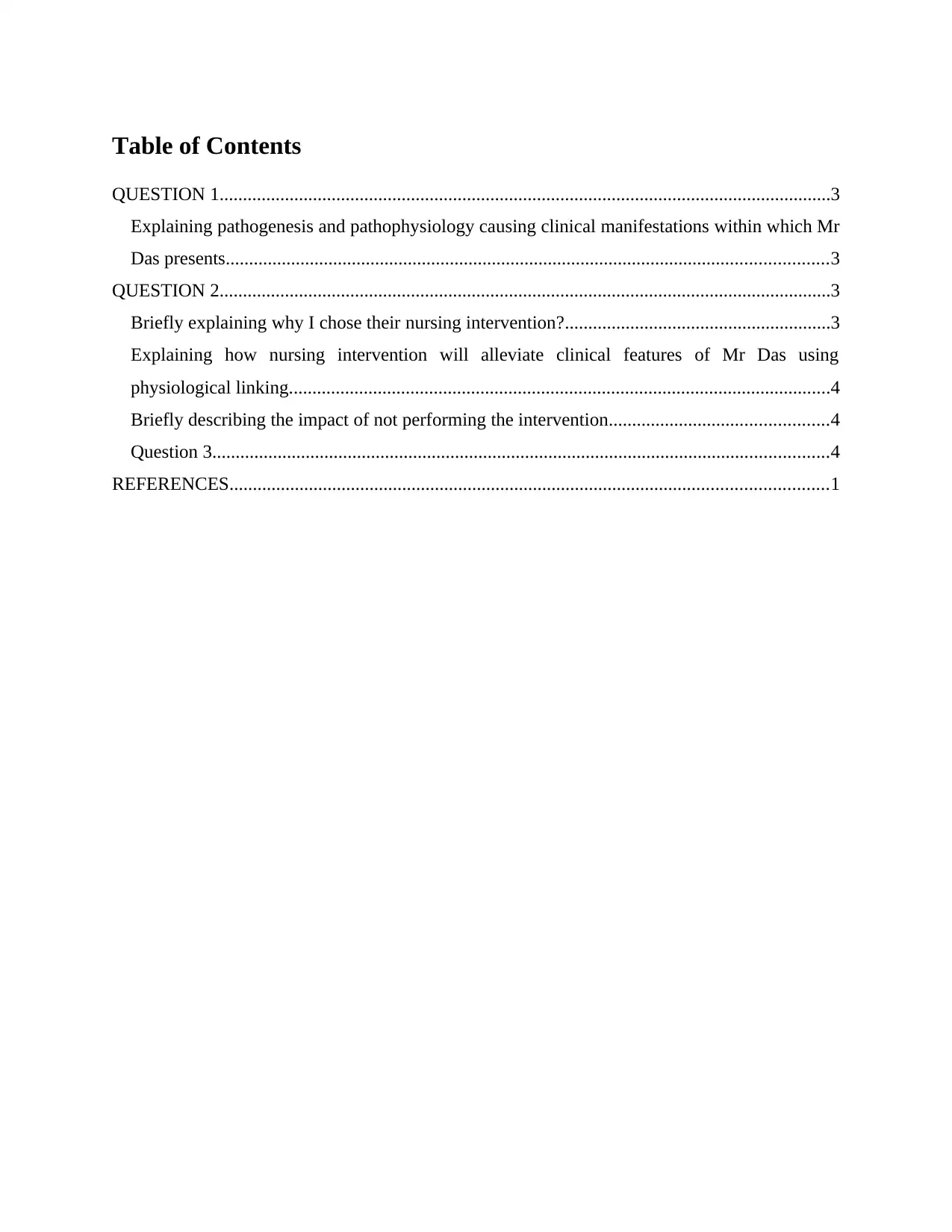
Table of Contents
QUESTION 1...................................................................................................................................3
Explaining pathogenesis and pathophysiology causing clinical manifestations within which Mr
Das presents.................................................................................................................................3
QUESTION 2...................................................................................................................................3
Briefly explaining why I chose their nursing intervention?.........................................................3
Explaining how nursing intervention will alleviate clinical features of Mr Das using
physiological linking....................................................................................................................4
Briefly describing the impact of not performing the intervention...............................................4
Question 3....................................................................................................................................4
REFERENCES................................................................................................................................1
QUESTION 1...................................................................................................................................3
Explaining pathogenesis and pathophysiology causing clinical manifestations within which Mr
Das presents.................................................................................................................................3
QUESTION 2...................................................................................................................................3
Briefly explaining why I chose their nursing intervention?.........................................................3
Explaining how nursing intervention will alleviate clinical features of Mr Das using
physiological linking....................................................................................................................4
Briefly describing the impact of not performing the intervention...............................................4
Question 3....................................................................................................................................4
REFERENCES................................................................................................................................1
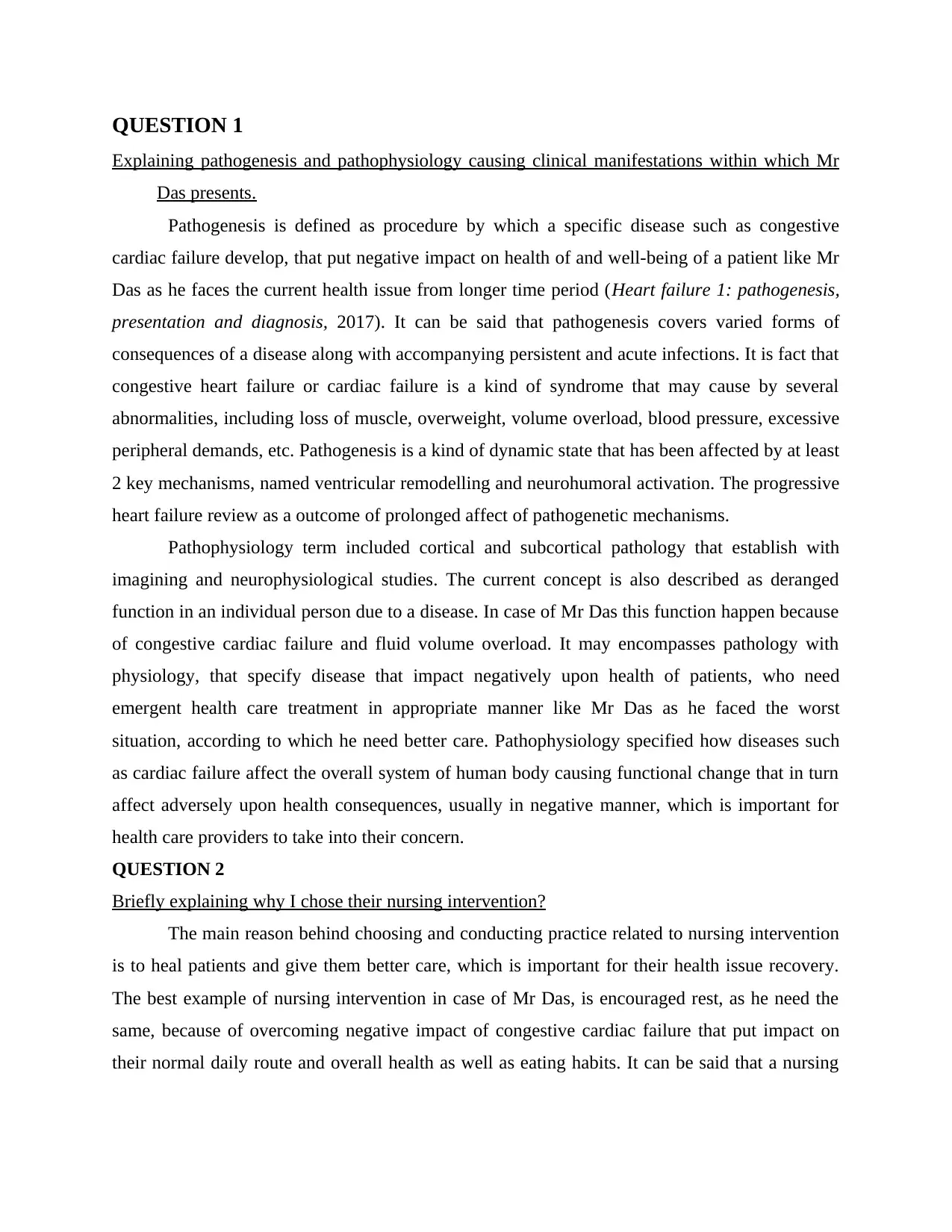
QUESTION 1
Explaining pathogenesis and pathophysiology causing clinical manifestations within which Mr
Das presents.
Pathogenesis is defined as procedure by which a specific disease such as congestive
cardiac failure develop, that put negative impact on health of and well-being of a patient like Mr
Das as he faces the current health issue from longer time period (Heart failure 1: pathogenesis,
presentation and diagnosis, 2017). It can be said that pathogenesis covers varied forms of
consequences of a disease along with accompanying persistent and acute infections. It is fact that
congestive heart failure or cardiac failure is a kind of syndrome that may cause by several
abnormalities, including loss of muscle, overweight, volume overload, blood pressure, excessive
peripheral demands, etc. Pathogenesis is a kind of dynamic state that has been affected by at least
2 key mechanisms, named ventricular remodelling and neurohumoral activation. The progressive
heart failure review as a outcome of prolonged affect of pathogenetic mechanisms.
Pathophysiology term included cortical and subcortical pathology that establish with
imagining and neurophysiological studies. The current concept is also described as deranged
function in an individual person due to a disease. In case of Mr Das this function happen because
of congestive cardiac failure and fluid volume overload. It may encompasses pathology with
physiology, that specify disease that impact negatively upon health of patients, who need
emergent health care treatment in appropriate manner like Mr Das as he faced the worst
situation, according to which he need better care. Pathophysiology specified how diseases such
as cardiac failure affect the overall system of human body causing functional change that in turn
affect adversely upon health consequences, usually in negative manner, which is important for
health care providers to take into their concern.
QUESTION 2
Briefly explaining why I chose their nursing intervention?
The main reason behind choosing and conducting practice related to nursing intervention
is to heal patients and give them better care, which is important for their health issue recovery.
The best example of nursing intervention in case of Mr Das, is encouraged rest, as he need the
same, because of overcoming negative impact of congestive cardiac failure that put impact on
their normal daily route and overall health as well as eating habits. It can be said that a nursing
Explaining pathogenesis and pathophysiology causing clinical manifestations within which Mr
Das presents.
Pathogenesis is defined as procedure by which a specific disease such as congestive
cardiac failure develop, that put negative impact on health of and well-being of a patient like Mr
Das as he faces the current health issue from longer time period (Heart failure 1: pathogenesis,
presentation and diagnosis, 2017). It can be said that pathogenesis covers varied forms of
consequences of a disease along with accompanying persistent and acute infections. It is fact that
congestive heart failure or cardiac failure is a kind of syndrome that may cause by several
abnormalities, including loss of muscle, overweight, volume overload, blood pressure, excessive
peripheral demands, etc. Pathogenesis is a kind of dynamic state that has been affected by at least
2 key mechanisms, named ventricular remodelling and neurohumoral activation. The progressive
heart failure review as a outcome of prolonged affect of pathogenetic mechanisms.
Pathophysiology term included cortical and subcortical pathology that establish with
imagining and neurophysiological studies. The current concept is also described as deranged
function in an individual person due to a disease. In case of Mr Das this function happen because
of congestive cardiac failure and fluid volume overload. It may encompasses pathology with
physiology, that specify disease that impact negatively upon health of patients, who need
emergent health care treatment in appropriate manner like Mr Das as he faced the worst
situation, according to which he need better care. Pathophysiology specified how diseases such
as cardiac failure affect the overall system of human body causing functional change that in turn
affect adversely upon health consequences, usually in negative manner, which is important for
health care providers to take into their concern.
QUESTION 2
Briefly explaining why I chose their nursing intervention?
The main reason behind choosing and conducting practice related to nursing intervention
is to heal patients and give them better care, which is important for their health issue recovery.
The best example of nursing intervention in case of Mr Das, is encouraged rest, as he need the
same, because of overcoming negative impact of congestive cardiac failure that put impact on
their normal daily route and overall health as well as eating habits. It can be said that a nursing
⊘ This is a preview!⊘
Do you want full access?
Subscribe today to unlock all pages.

Trusted by 1+ million students worldwide
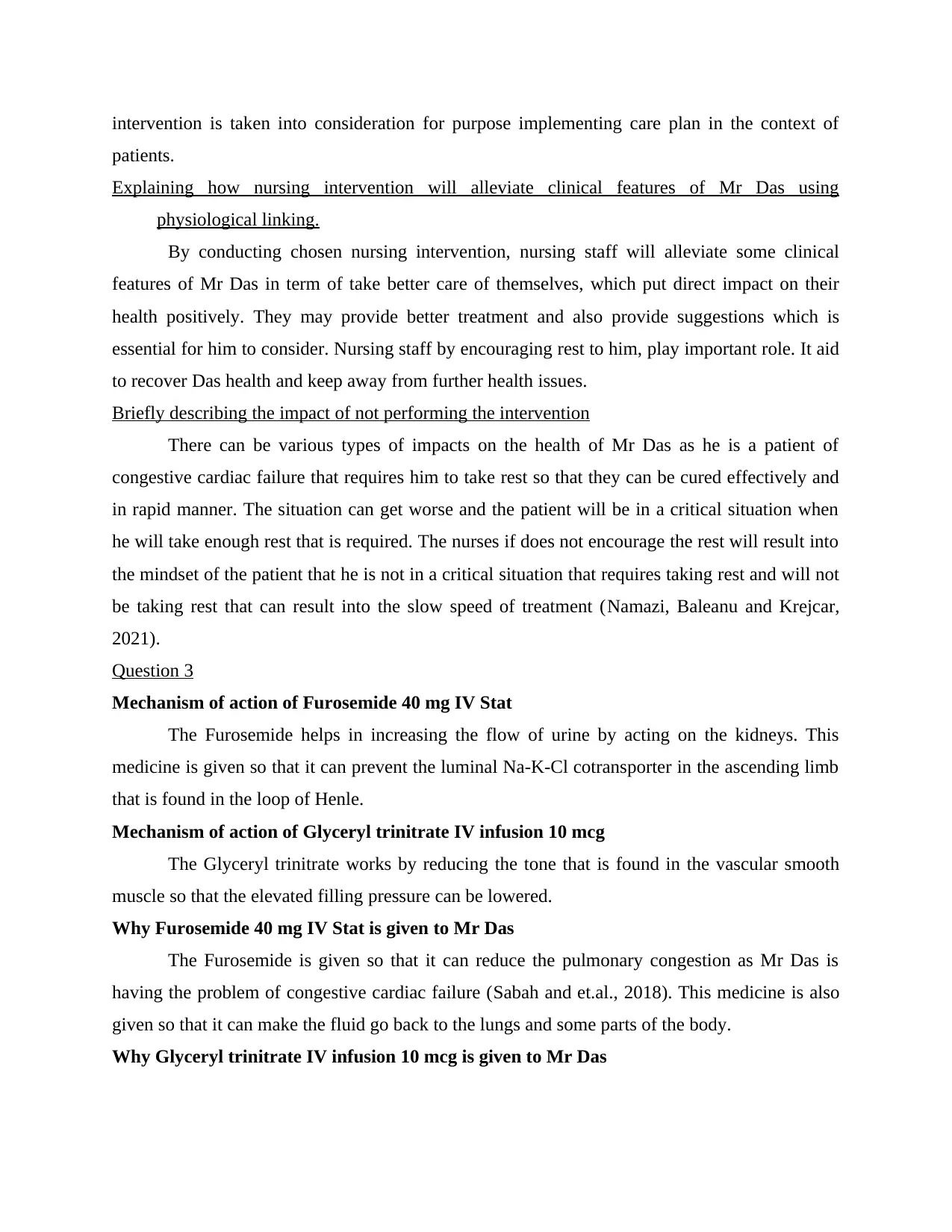
intervention is taken into consideration for purpose implementing care plan in the context of
patients.
Explaining how nursing intervention will alleviate clinical features of Mr Das using
physiological linking.
By conducting chosen nursing intervention, nursing staff will alleviate some clinical
features of Mr Das in term of take better care of themselves, which put direct impact on their
health positively. They may provide better treatment and also provide suggestions which is
essential for him to consider. Nursing staff by encouraging rest to him, play important role. It aid
to recover Das health and keep away from further health issues.
Briefly describing the impact of not performing the intervention
There can be various types of impacts on the health of Mr Das as he is a patient of
congestive cardiac failure that requires him to take rest so that they can be cured effectively and
in rapid manner. The situation can get worse and the patient will be in a critical situation when
he will take enough rest that is required. The nurses if does not encourage the rest will result into
the mindset of the patient that he is not in a critical situation that requires taking rest and will not
be taking rest that can result into the slow speed of treatment (Namazi, Baleanu and Krejcar,
2021).
Question 3
Mechanism of action of Furosemide 40 mg IV Stat
The Furosemide helps in increasing the flow of urine by acting on the kidneys. This
medicine is given so that it can prevent the luminal Na-K-Cl cotransporter in the ascending limb
that is found in the loop of Henle.
Mechanism of action of Glyceryl trinitrate IV infusion 10 mcg
The Glyceryl trinitrate works by reducing the tone that is found in the vascular smooth
muscle so that the elevated filling pressure can be lowered.
Why Furosemide 40 mg IV Stat is given to Mr Das
The Furosemide is given so that it can reduce the pulmonary congestion as Mr Das is
having the problem of congestive cardiac failure (Sabah and et.al., 2018). This medicine is also
given so that it can make the fluid go back to the lungs and some parts of the body.
Why Glyceryl trinitrate IV infusion 10 mcg is given to Mr Das
patients.
Explaining how nursing intervention will alleviate clinical features of Mr Das using
physiological linking.
By conducting chosen nursing intervention, nursing staff will alleviate some clinical
features of Mr Das in term of take better care of themselves, which put direct impact on their
health positively. They may provide better treatment and also provide suggestions which is
essential for him to consider. Nursing staff by encouraging rest to him, play important role. It aid
to recover Das health and keep away from further health issues.
Briefly describing the impact of not performing the intervention
There can be various types of impacts on the health of Mr Das as he is a patient of
congestive cardiac failure that requires him to take rest so that they can be cured effectively and
in rapid manner. The situation can get worse and the patient will be in a critical situation when
he will take enough rest that is required. The nurses if does not encourage the rest will result into
the mindset of the patient that he is not in a critical situation that requires taking rest and will not
be taking rest that can result into the slow speed of treatment (Namazi, Baleanu and Krejcar,
2021).
Question 3
Mechanism of action of Furosemide 40 mg IV Stat
The Furosemide helps in increasing the flow of urine by acting on the kidneys. This
medicine is given so that it can prevent the luminal Na-K-Cl cotransporter in the ascending limb
that is found in the loop of Henle.
Mechanism of action of Glyceryl trinitrate IV infusion 10 mcg
The Glyceryl trinitrate works by reducing the tone that is found in the vascular smooth
muscle so that the elevated filling pressure can be lowered.
Why Furosemide 40 mg IV Stat is given to Mr Das
The Furosemide is given so that it can reduce the pulmonary congestion as Mr Das is
having the problem of congestive cardiac failure (Sabah and et.al., 2018). This medicine is also
given so that it can make the fluid go back to the lungs and some parts of the body.
Why Glyceryl trinitrate IV infusion 10 mcg is given to Mr Das
Paraphrase This Document
Need a fresh take? Get an instant paraphrase of this document with our AI Paraphraser
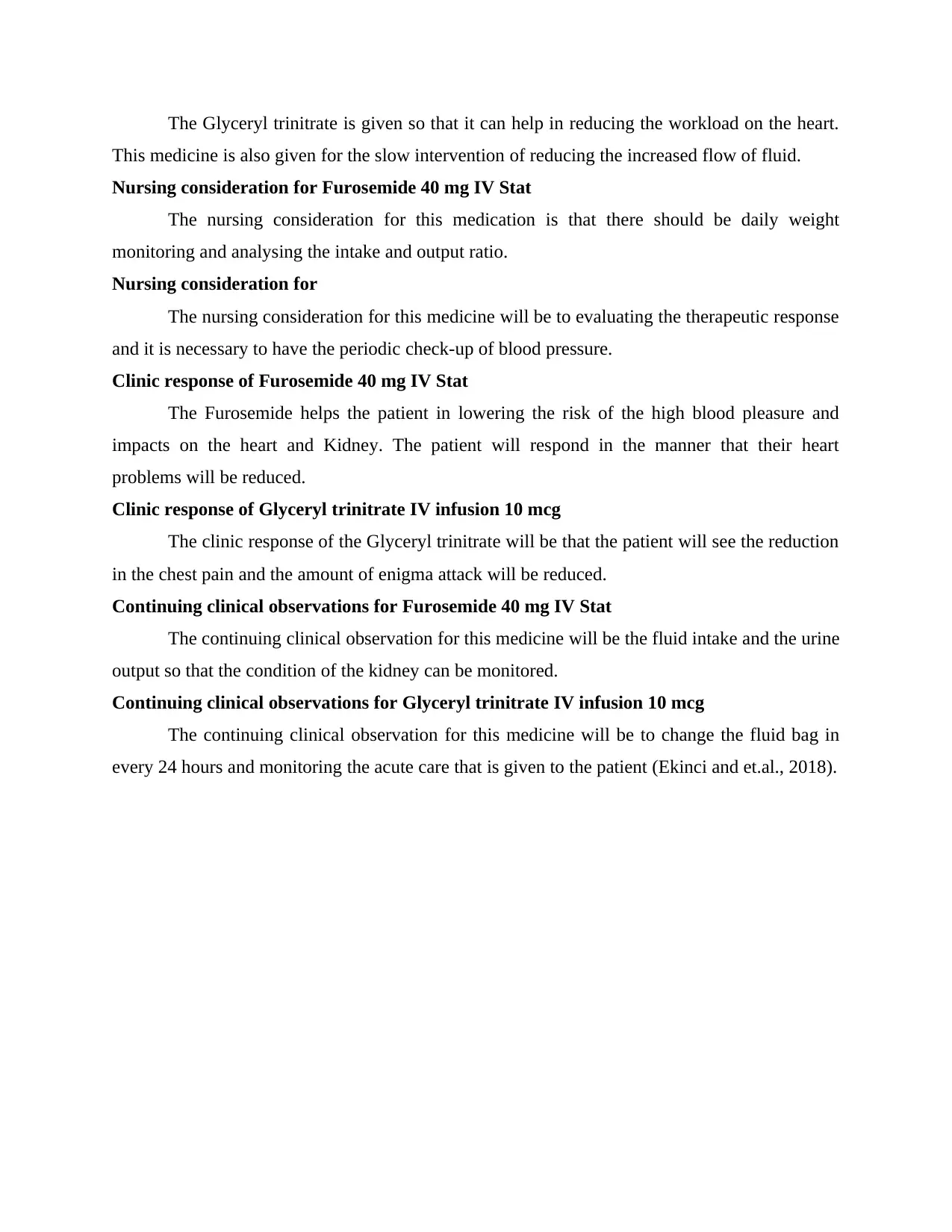
The Glyceryl trinitrate is given so that it can help in reducing the workload on the heart.
This medicine is also given for the slow intervention of reducing the increased flow of fluid.
Nursing consideration for Furosemide 40 mg IV Stat
The nursing consideration for this medication is that there should be daily weight
monitoring and analysing the intake and output ratio.
Nursing consideration for
The nursing consideration for this medicine will be to evaluating the therapeutic response
and it is necessary to have the periodic check-up of blood pressure.
Clinic response of Furosemide 40 mg IV Stat
The Furosemide helps the patient in lowering the risk of the high blood pleasure and
impacts on the heart and Kidney. The patient will respond in the manner that their heart
problems will be reduced.
Clinic response of Glyceryl trinitrate IV infusion 10 mcg
The clinic response of the Glyceryl trinitrate will be that the patient will see the reduction
in the chest pain and the amount of enigma attack will be reduced.
Continuing clinical observations for Furosemide 40 mg IV Stat
The continuing clinical observation for this medicine will be the fluid intake and the urine
output so that the condition of the kidney can be monitored.
Continuing clinical observations for Glyceryl trinitrate IV infusion 10 mcg
The continuing clinical observation for this medicine will be to change the fluid bag in
every 24 hours and monitoring the acute care that is given to the patient (Ekinci and et.al., 2018).
This medicine is also given for the slow intervention of reducing the increased flow of fluid.
Nursing consideration for Furosemide 40 mg IV Stat
The nursing consideration for this medication is that there should be daily weight
monitoring and analysing the intake and output ratio.
Nursing consideration for
The nursing consideration for this medicine will be to evaluating the therapeutic response
and it is necessary to have the periodic check-up of blood pressure.
Clinic response of Furosemide 40 mg IV Stat
The Furosemide helps the patient in lowering the risk of the high blood pleasure and
impacts on the heart and Kidney. The patient will respond in the manner that their heart
problems will be reduced.
Clinic response of Glyceryl trinitrate IV infusion 10 mcg
The clinic response of the Glyceryl trinitrate will be that the patient will see the reduction
in the chest pain and the amount of enigma attack will be reduced.
Continuing clinical observations for Furosemide 40 mg IV Stat
The continuing clinical observation for this medicine will be the fluid intake and the urine
output so that the condition of the kidney can be monitored.
Continuing clinical observations for Glyceryl trinitrate IV infusion 10 mcg
The continuing clinical observation for this medicine will be to change the fluid bag in
every 24 hours and monitoring the acute care that is given to the patient (Ekinci and et.al., 2018).

⊘ This is a preview!⊘
Do you want full access?
Subscribe today to unlock all pages.

Trusted by 1+ million students worldwide
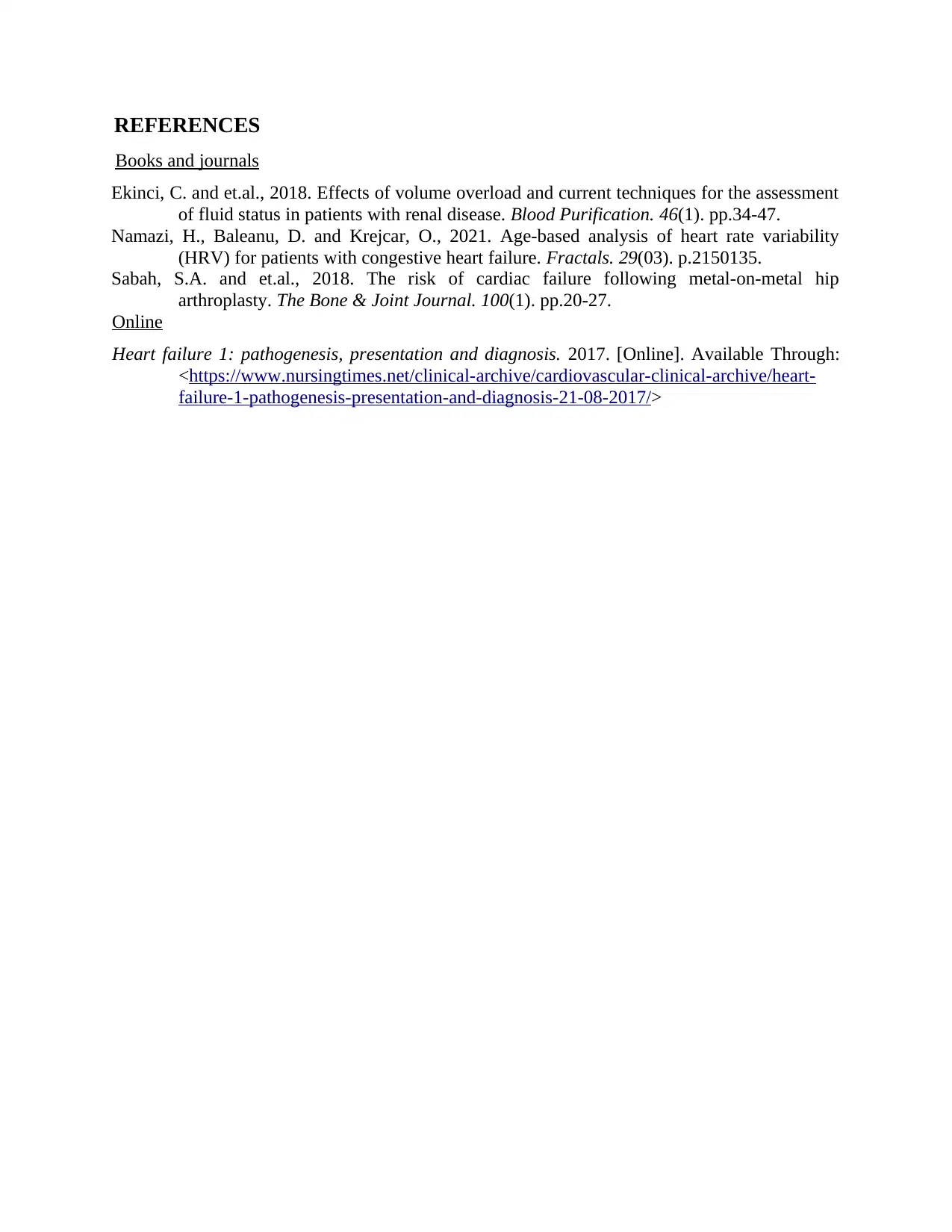
REFERENCES
Books and journals
Ekinci, C. and et.al., 2018. Effects of volume overload and current techniques for the assessment
of fluid status in patients with renal disease. Blood Purification. 46(1). pp.34-47.
Namazi, H., Baleanu, D. and Krejcar, O., 2021. Age-based analysis of heart rate variability
(HRV) for patients with congestive heart failure. Fractals. 29(03). p.2150135.
Sabah, S.A. and et.al., 2018. The risk of cardiac failure following metal-on-metal hip
arthroplasty. The Bone & Joint Journal. 100(1). pp.20-27.
Online
Heart failure 1: pathogenesis, presentation and diagnosis. 2017. [Online]. Available Through:
<https://www.nursingtimes.net/clinical-archive/cardiovascular-clinical-archive/heart-
failure-1-pathogenesis-presentation-and-diagnosis-21-08-2017/>
Books and journals
Ekinci, C. and et.al., 2018. Effects of volume overload and current techniques for the assessment
of fluid status in patients with renal disease. Blood Purification. 46(1). pp.34-47.
Namazi, H., Baleanu, D. and Krejcar, O., 2021. Age-based analysis of heart rate variability
(HRV) for patients with congestive heart failure. Fractals. 29(03). p.2150135.
Sabah, S.A. and et.al., 2018. The risk of cardiac failure following metal-on-metal hip
arthroplasty. The Bone & Joint Journal. 100(1). pp.20-27.
Online
Heart failure 1: pathogenesis, presentation and diagnosis. 2017. [Online]. Available Through:
<https://www.nursingtimes.net/clinical-archive/cardiovascular-clinical-archive/heart-
failure-1-pathogenesis-presentation-and-diagnosis-21-08-2017/>
Paraphrase This Document
Need a fresh take? Get an instant paraphrase of this document with our AI Paraphraser

2
1 out of 8
Related Documents
Your All-in-One AI-Powered Toolkit for Academic Success.
+13062052269
info@desklib.com
Available 24*7 on WhatsApp / Email
![[object Object]](/_next/static/media/star-bottom.7253800d.svg)
Unlock your academic potential
Copyright © 2020–2025 A2Z Services. All Rights Reserved. Developed and managed by ZUCOL.




